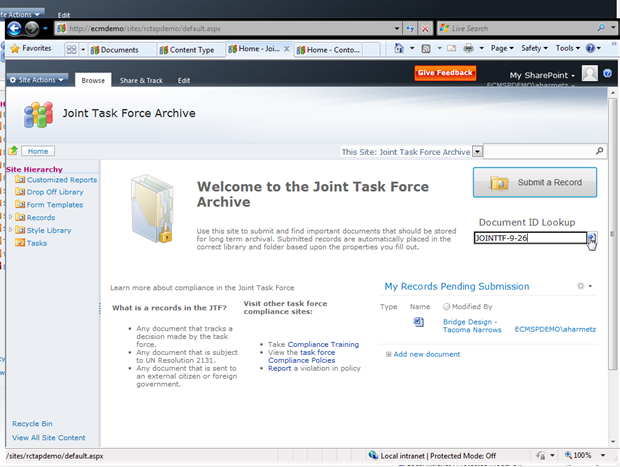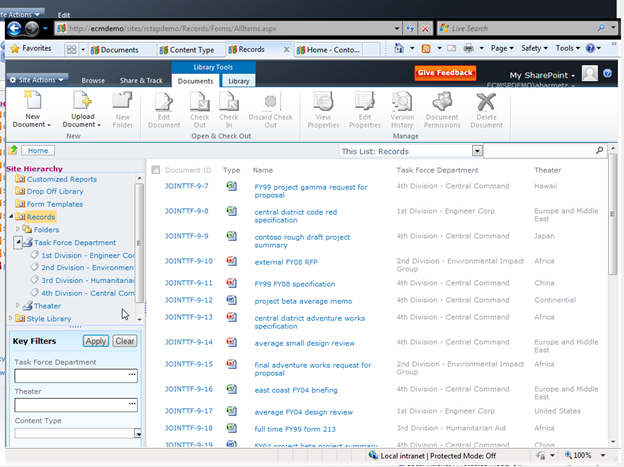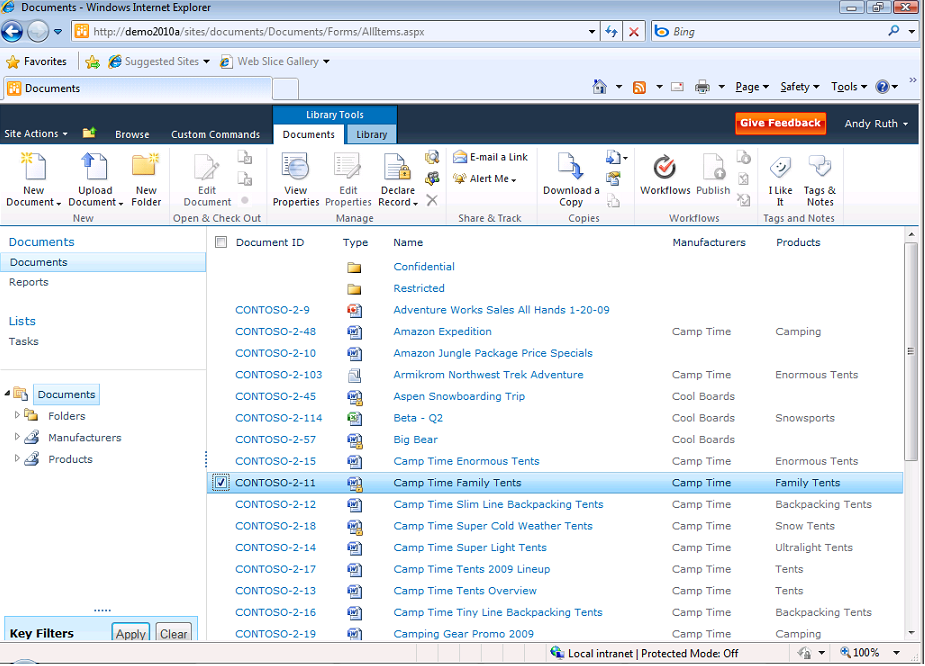Introducing Records Management in SharePoint 2010
Hi everyone. My name is Adam Harmetz and I work on the engineering team responsible for the SharePoint document and records management vision and features. Many of you might remember me from the SharePoint 2007 recman blog. The recman blog was a great way for the team to connect with records managers, IT professionals, and information architects and we'll be continuing that discussion for the SharePoint 2010 compliance features via the Enterprise Content Management (ECM) Team Blog.
I think it makes sense to combine records management with other facets of ECM into one central blog. After all, as Jim discussed, records management is a key component of our ECM strategy. The notion that everyone should participate in ECM processes really served as a guiding principle to help expand the scope of records management in SharePoint 2010. And for all you records managers out there, I think you'll benefit greatly from learning about the other facets of ECM along the way.
To kick off the discussion, here are three key things you need to know about records management in SharePoint 2010.
The Records Center - A Place for Hierarchy, Driven By Metadata
The Records Center was introduced in 2007 as a SharePoint site that served as a conventional records archive. Content from all over the enterprise can be submitted to a Records Center and then routed to the appropriate place where it picks up the right permissions and policies, such as expiration and auditing.
For SharePoint 2010, we know it's important to continue to invest here and add even more "traditional" archive features. When looking at the broad swath of features we had to choose from, our goals here really focused on providing features that allow you to extract the most value out of an archive and find the data you need. For instance, here are a few of the new features in a SharePoint 2010 Records Center:
- Document ID: Every document can be assigned a unique identifier, which stays with the document even when it's archived. This allows records to be easily referenced by an ID no matter where the document moves.
- Multi-Stage Retention: Retention policies can have multiple stages, allowing you to specify the entire document lifecycle as one policy (e.g. review Contracts every year, and delete after 7 years)
- Per-Item Audit Reports: You can generate a customized audit report about an individual record.
- Hierarchal File Plans: You can create deep, hierarchal folder structures and manage retention at each folder in the hierarchy (or inherit from parent folders).
- File Plan Report: You can generate status reports showing the number of items in each stage of the file plan, along with a rollup of the retention policies on each node in the plan.

Here's the home page of the Records Center in SharePoint 2010 for a fictional government agency, the Joint Task Force. Notice that the home page is a place for records managers to educate the organization on compliance policy, as well as a place to look up a record by its document identifier.
In addition to adding these traditional records management features to our archive, as product designers we made a big bet on the power of metadata to dive 21st century electronic records management. This manifests itself in several ways in the SharePoint archive:
- Taxonomy and Centralized Content Types: The archive will be a consumer of enterprise-wide taxonomies and content types, ensuring consistency and context transfer between the collaborative spaces and the archive. We'll be talking a lot more about our 2010 taxonomy investments in future posts.
- Content Organizer: The records router can use metadata to route incoming documents to the right place in the hierarchical file plan. For instance, it enables you to automatically enforce rules on content that is submitted, like "If a Purchase Agreement is tagged with Project Alpha, send to the Alpha Contracts subfolder and apply that's folder retention policy to the item."
- Virtual Folders: The file plan is a great way to manage a repository but often time isn't what you want to use to navigate and find the content you are looking for. The SharePoint 2010 Records Center makes use of a new feature called metadata based navigation, which allows you to expose key metadata as virtual folders:

Notice that end users discover content in this Records Center by navigating virtual folders based upon metadata properties on the records.
This bet on metadata is all about empowering the end user, thus increasing the chance of successful adoption of the RM system. Instead of choosing a complicated node in a file plan, submitters just fill out a few pieces of useful metadata and they'll use that metadata when they need to find the content again.
In Place Records Management - Injecting Records Management in the Content Creation Experience
With just about every customer engagement my team is involved in, we hear the same message again and again: records management doesn't start (or stop!) in the archive. Content isn't created there and it sure doesn't live there for the most interesting parts of its life.
We've made a huge effort in 2010 to enable you to do effective records management in collaborative spaces. Auditing, Retention, Expiration, Reporting, Records Workflows, eDiscovery, Legal Hold and Recordization are all features you can use in collaborative space as you are striking a balance between SharePoint's value to end users and the need for information governance.
Holding all of this together is a new feature in SharePoint 2010 called In Place Records Management. This allows certain SharePoint documents (or blogs, wikis, web pages, and list items) to be declared records. The system can prevent such records from being deleted or edited, if necessary by your organization's definition of what a record is:

Note that some of the documents have locks, implying to the user that they are dealing with records. When selecting a record, the UI for editing and deleting the item is disabled.
This recordization process can be done either manually, as part of a larger process in a workflow, or as a scheduled part of a document's retention (e.g. after 2 years). The key here is that, when declared a record, the content doesn't move to an archive - it stays where it is so the end users can still find and interact with the content.
Once declared, the system knows about an item's record status, so you can do things such as create different retention policies for records or use record state when defining workflows in SharePoint Designer. We also enable a programmability model so you can perform custom processes and policies upon recordization to meet specialized compliance needs.
Is In Place Records a replacement for a traditional archive? The answer is, of course, sometimes - we'll find some customers who want to use an in place approach exclusively, some who will want the traditional hierarchy and centralization that an archive brings, and many who will want both. It'll be something we'll talk about a lot on this blog, and our documentation has already started discussing the pros and cons of both approaches.
Scale: We're Talking Big
With electronic information growing at a crazy pace and businesses spending billions on eDiscovery every year, records managers have enough to keep them up at night. The scale of their records/content management system shouldn't be another worry.
As the records management engineering team, we take this burden very seriously and a large part of our effort this release has been spent adding features to make it easier to scale to massive archives. Features such as Remote Blob Storage, database query optimizations, internal timer job processing improvements, new database indexing strategies and other engineering initiatives enable us to make a great leap forward this release and allow our customers to have:
- Tens of millions of records in a single Records Center
- Hundreds of millions of records in a distributed archive: We'll talk in more detail in future posts, but many of the features mentioned above light up to allow many Record Centers to bind together to act as one logical repository.
With our partners on the SharePoint blog, we are looking forward to showing more details on the new scale targets and performance profiles for deployments at this scale over the coming months.
Wrapping Up
It's been a lot of hard work for the team around here to deliver on this vision for 21st century records management. When combined with the integrated e-mail archiving, retention, and discovery capabilities of Exchange 2010, I think you'll see the 2010 wave as a breakout release for Microsoft's records management strategy.
The team here is proud of the work here and eager to talk about it and hear from everyone - feel free to leave suggestions on future blog post ideas in the comments!
Thanks for reading,
Adam Harmetz
Lead Program Manager
P.S. If you are hungry for even for information on SharePoint 2010 records management, check out an interview I did on Don Lueder's blog.
Comments
Anonymous
February 23, 2010
Its excellent. I was searching since morning... Finally i got this right... Thanks you made my day.Anonymous
March 12, 2010
Informative post Adam...thanks. One question - your post seems to indicate a separation between in-place RM and archive RM. Will SP2010 support a mixture where a link or stub is left in the document library for those documents that have been sent to the record center?Anonymous
March 16, 2010
Does SharePoint 2010 RM meet the DoD 5015.02 spec? I don't see it listed on the DoD's product register (http://jitc.fhu.disa.mil/recmgt/register.html) although Sharepoint is listed as a foundation for a number of other Vendor products listed in the registry. thanks. DanAnonymous
March 30, 2010
There is any add -ons in sharePoint which handled records management system frequently.Anonymous
April 02, 2010
I think many records managers still have to deal with paper records, either as older, pre-imaging content or current workflow that just does not lend itself to remaining electronic (realizing that most, if not all, documents are born electronic) or being scanned. I still have not seen anything about how, or even IF, SP2010 will manage paper records processes, such as indexing, check-out/check-in and tracking of folders both on-site and at off-site storage repositories/vendors.Anonymous
April 15, 2010
As far as the per-item audit reporting, can a user see the history (audit info) from the document libraries?Anonymous
June 15, 2010
How do we upgrade a records center site from 2007 to 2010?Anonymous
June 30, 2010
Hello, thank for this precise post. Question : do you have study the compatibility for sharepoint 2010 RM with the new standard ISO 16175 (same text than the ICA text) ? Wath are your conclusions ? Best Regards PierreAnonymous
December 29, 2010
Hi Adam, Thanks for working hard to improve the RM capabilities in SharePoint! I look forward to what you and your team come up with for the next release. On another note, I think you will be interested in the SharePoint Records Management Accelerator solution that Collabware (http://www.collabware.com) has created for SharePoint 2010. All the best, GrahamAnonymous
January 27, 2012
Are Ryan Duguid and Adam Harmetz the same person or did Ryan Dugid post this article on behalf of Adam Harmetz?